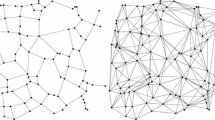Abstract
We re-examine the probabilistic analysis of Clarkson and Shor [5] involvingk-sets of point sets and related structures. By studying more carefully the equations that they derive, we are able to obtain refined analysis of these quantities, which lead to a collection of interesting relationships involvingk-sets, convex hulls of random samples, and generalizations of these constructs.
Similar content being viewed by others
References
N. Alon, andE. Győri: The number of small semispaces of a finite set of points in the plane,J. Combin. Theory Ser. A 41 (1986), 154–157.
B. Aronov, B. Chazelle, H. Edelsbrunner, L. Guibas, M. Sharir andR. Wenger: Points and triangles in the plane and halving planes in space,Discrete Comput. Geom. 6 (1991), 435–442.
I. Bárány, Z. Füredi, andL. Lovász: On the number of halving planes,Proc. 5th ACM Symp. on Computational Geometry, 1989, 140–144.
Brønstad:An introduction to Convex Polytopes, Springer-Verlag, Heidelberg 1983.
K. Clarkson, andP. Shor: Applications of random sampling in computational geometry, II,Discrete Comput. Geom. 4 (1989), 387–421.
H. Edelsbrunner, andE. Welzl: On the number of line separations of a finite set in the plane,J. Combin. Theory Ser. A 38 (1985), 15–29.
P. Erdős, L. Lovász, A. Simmons, andE. G. Strauss: Dissection graphs of planar point sets, InA Survey of Combinatorial Theory, J. N. Srivastava et al., eds., North-Holland, Amsterdam, 1973, 139–149.
J. E. Goodman, andR. Pollack: On the number ofk-subsets of a set ofn points in the plane,J. Combin. Theory, Ser. A 36 (1984), 101–104.
R. Graham, D. Knuth, andO. Patashnik:Concrete Mathematics, Addison-Wesley, Reading, MA, 1989.
L. Guibas, D. Knuth, andM. Sharir: Randomized incremental construction of Delaunay and Voronoi Diagrams,Algorithmica 7 (1992), 381–413.
L. Lovász: On the number of halving lines,Ann. Univ. Sci. Budapest, Eötvös, Sect. Math. 14 (1971), 107–108.
C. Ó'Dúnlaing, K. Mehlhorn, andS. Meiser: Abstract Voronoi diagrams, manuscript, 1989.
J. Pach, W. Steiger, andE. Szemerédi: An upper bound on the number of planark-sets,Proc. 30th IEEE Symp. on Foundations of Computer Science, 1989, 72–79.
M. Sharir: Onk-sets in arrangements of curves and surfaces,Discrete Comput. Geom. 6 (1991), 593–613.
E. Yaniv: Randomized incremental construction of Delaunay triangulations: Theory and practice, M. Sc. thesis, Tel Aviv University, Tel Aviv, Israel, 1991.
Author information
Authors and Affiliations
Additional information
Work on this paper has been supported by Office of Naval Research Grant N00014-89-J-3042 and N00014-90-J-1284, by National Science Foundation Grant CCR-89-01484, and by grants from the U.S.-Israeli Binational Science Foundation, the Fund for Basic Research administered by the Israeli Academy of Sciences, and the G.I.F., the German-Israeli Foundation for Scientific Research and Development.




